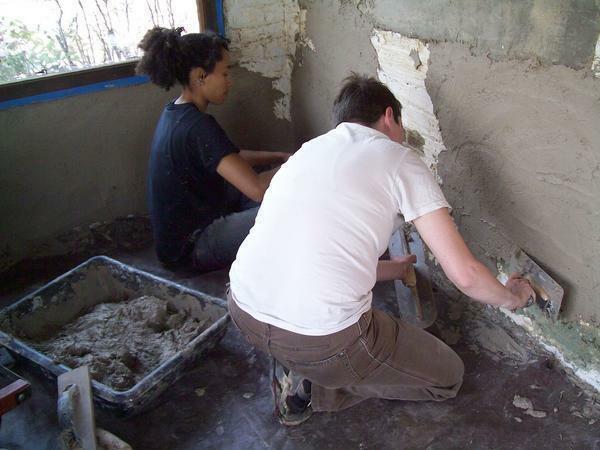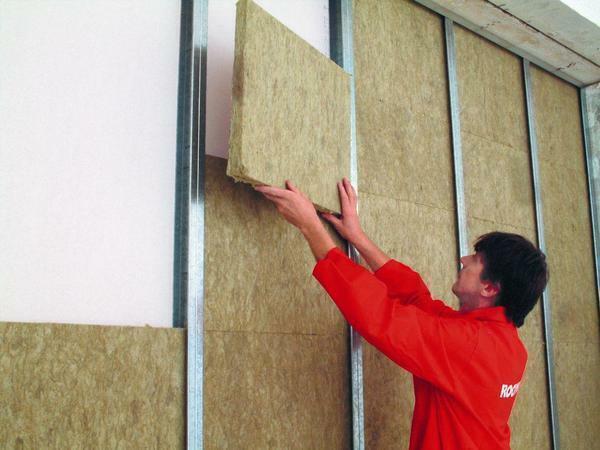
Warming inside the house - a procedure containing tasks mass, one of which is the choice of material
If we talk about the facade insulation, the owners of such housing are faced with certain difficulties:
- the high cost of professional fees (external insulation of the house due to its complexity hard to perform with his own hands, so you have to hire experts to carry out work at height);
- at an inconvenient location of the apartment is impossible to perform the procedure of external insulation (such structural elements of the building as a stairwell or elevator shaft creates serious obstacles to outdoor works);
- restrictions on the architectural appearance of the building (most of the old buildings is decorated with precious materials, some of them are architectural monuments, as well as historical and cultural monuments, so the city authorities impose a veto on any changes to the front part of such structures).

It should be remembered that the installation of the walls sufficiently thick layer of insulation will reduce the floor space
Note! Over the past decade, at a party, and building codes were introduced some amendments, so the possibility of cladding or internal insulation of each individual house should be considered individually order.
What are the drawbacks accompanied by the fixing heaters to the wall from the inside
If you for some reason, decided to carry out the procedure of warming the inside of the building, it is necessary to analyze in advance all the shortcomings of the event. This will allow you to avoid mistakes and to choose the right material.

insulation material must be harmless to health, stable to high temperatures, durable and rugged
Compliance with all requirements of technology increases the total cost of the work, and any breach of the rules of the risk of failure occurs.
Insulation for walls of the house inside: the dew point and its impact
there is such a thing as a "dew point" in terms of construction. It is a measure, responsible for the formation of condensate inside the walls of the building. Irrespective of density insulation for walls, any of the materials causes the formation of condensate. By itself, this is a natural process and is triggered by the impact of temperature changes on the humidity.
Note! Internal insulation is more conducive to the formation of condensation, not only on the walls, but also within them. Especially the lack of relevance for the wooden houses, as wood is highly susceptible to the detrimental effects of moisture.

The type and thickness of the insulation wall and the dew point depends on the position
According to the laws of physics, condensation occurs inside the structures occurs when the index temperature reaches 10,7 ° C.
In a building with a facade insulation walls heat up due to internal room temperature. On the outer side of the cold protection is provided an interlayer insulation material. Due to its unique properties, thermal insulators, which can be evaluated by the thermal conductivity of the table of heaters, the temperature of these materials is practically not subject to change. Therefore, when the dew point occurs, its effect will be superficial or even be in the plasterWhich dries independently.
When the internal insulation from the outside of the building wall nothing protects against cold, hence, dew point will be located inside the structure. Each year, the amount of moisture will increase, and due to the continuous freezing and thawing of water walling will undergo destruction.

A wide range of thermal insulation materials for walls allow everyone to choose the most suitable insulation
Choosing insulation inside walls: the materials, their classification and characteristics
To determine which is best insulation for walls or wooden frame house, you need to compare the characteristics of each of the materials, the advantages and disadvantages. This will allow you to create a full picture and make the right choice.
Note! Heaters are used in all constructions planes. The only way you will be able to eliminate heat loss and to create optimal conditions for living climate indoors. Thermal insulation is placed even on external walls, attic and basement ceilings.
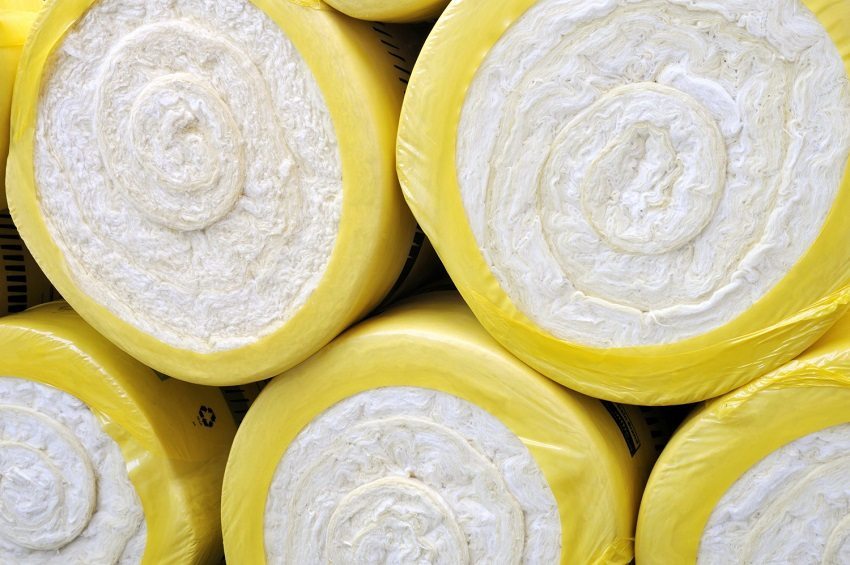
Mineral wool is a traditional material for internal insulation of walls
Some insulation for the walls is best to buy: the factors influencing the choice of insulation
The formula for calculating the insulation thickness for walls is based on the level of thermal conductivity walling that are already installed, as well as the peculiarities of the climate zone. Perform the calculated manipulation can design having a suitable profile or heating engineer highly qualified.
Specialist will take several settings to perform calculations:
- The thickness of the walls in the room.
- The material from which the walls of the building.
- Type of insulating material, which you have chosen for insulation works.
- Most minimum temperature display, which was observed in the room in the presence of heat.

For the insulating walls inside the mineral wool used trim frame
Professional for the settlement will take about 20-30 minutes. time. To determine the correct thickness of the insulating material can not visually because there is a high probability of error.
To calculate the thickness required to calculate the heat transfer resistance (R):
D / L = Rwhere
L - thermal conduction coefficient of the material,
D - wall thickness.
The thickness of the insulation is determined by the inverse formula:
LxR = D.
The key point of the material of choice for the insulation walls are physical parameters, namely, vapor permeability and thermal conductivity. It is recommended to take the thickness of the material with a small margin.
Table for calculating insulation wall thickness:
| Type of insulation | Density (kg / m³) | The temperature for the calculation | |
| -25 ° C | -35ºS | ||
| Perlite, glass wool, rock wool | 200 | 10 cm | 15 cm |
| expanded clay aggregate | 500 | 20 cm | 30 cm |
| Slag | 1000 | 30 cm | 40 cm |
insulation properties to the inside walls: basic characteristics
When choosing materials should first be based on the properties and characteristics of the heaters.
The most important characteristics to determine which is best insulation for walls of wooden houses inside are:
- thermal conductivity - a key indicator for selection of insulating materials. The smaller the insulation is able to retain heat in the room, the greater the need to install the insulation material. This index is a direct function of the level of hygroscopicity;
- density - another indicator that affects the level of thermal conductivity. It largely determines the characteristics of surfaces with different types of accommodation. The higher the density, the greater level of thermal conductivity;
- hygroscopicity - materials with low absorbing properties characterized by poor, which reduces the level of thermal conductivity. Hygroscopicity depends on the durability of insulation and the choice of material for these works.
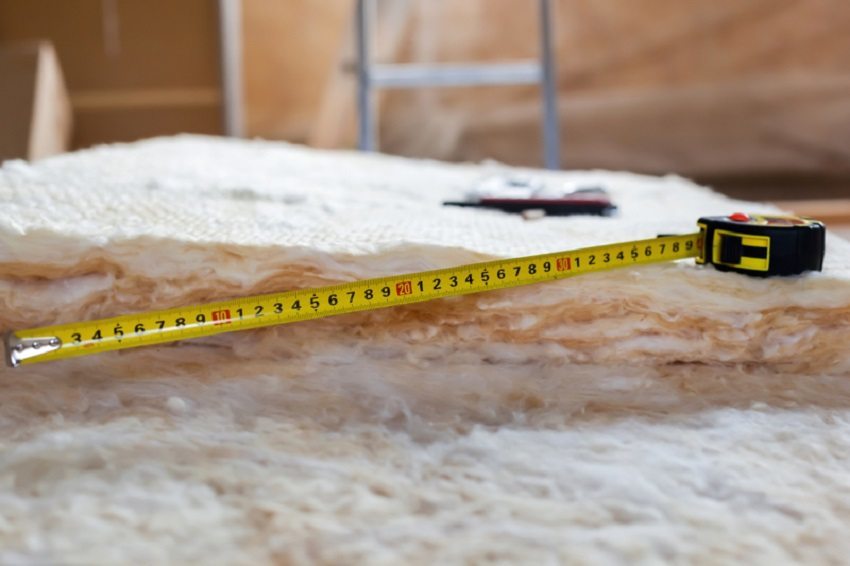
Prior to installation of insulation it is important to calculate the necessary amount of material
Useful advice! Wall insulation is recommended to do in the warmer months. Walls should be well dried.
In addition to the physical properties of insulation also possess mechanical properties. As part of this feature are 4 classes of materials:
- Vata - roll type insulation and other products that are made with its use.
- Bulk - penoveschestva or granular materials in the form of crumbs having a different size fractions.
- Concrete blocks - as a raw material for producing glass is used, foamed concrete and other materials having suitable properties.
- Plates - products in the form of plates, obtained by pressing and bonding (may have different dimensional parameters).

When working with mineral wool for the use of respiratory protection masks and skin protection - special clothing and gloves
Insulating properties of materials for walls
Despite the wide range of materials for insulating walls, represented in the construction market, there is no insulation, which could offer the universal characteristics and properties.
Useful advice!If you think about how to insulate the walls from the inside corner to the apartment or room in a wooden house, in each case the choice of material will be different. It should focus on the most important characteristics.
Comparative table of material properties:
| material class | Identification of the substance | Minimum layer, cm | Density (kg / m³) | absorbability | Thermal conductivity |
| bulk | Slag | 30 | 1000 | B | BUT |
| expanded clay aggregate | 20 | 500 | D | B | |
| Steklopor | 10 | 15-120 | BUT | D | |
| Vermiculite, perlite | 10 | 40-100 | BUT | D | |
| basalt fiber | 15 | 130 | B | D | |
| Round | fiberglass | 10-15 | 75-175 | B | D |
| rockwool | 10-15 | 35-125 | B | D | |
| wired mats | 10-15 | 75-150 | B | D | |
| Plastiform | 2 | 50-60 | D | D | |
| Isover, Ursa | 10-15 | 35-125 | B | D | |
| penofol | 5 | 60-70 | AT | D | |
| Expanded polystyrene | 10 | 30-40 | AT | D | |
| Polyurethane foam | 10 | 30-60 | AT | D | |
| Plitno-sheet | Styrofoam | 10 | 35-50 | AT | D |
| Mipora | 10 | 25-40 | AT | D | |
| Rockwool glass wool + | 10-15 | 75-250 | B | D | |
| Wood fiber | 1,5-3 | 250 | BUT | B | |
| Air blocks | expanded clay lightweight concrete | 40 | 1000 | AT | BUT |
| foam concrete | 25 | 600 | B | B | |
| aerated concrete | 20-40 | 400-800 | B | B | |
| cellular concrete | 20-40 | 400-800 | B | B | |
| Gas silicate blocks | 20-40 | 400-800 | B | B |
Parameters hygroscopic and thermal conductivity:
- A - very high;
- B - high;
- B - average;
- D - Low;
- D - is very low.
Related article:
Installation of insulation to the walls inside the house in the country. Forms and installation of insulation for the walls inside the house. Detailed characteristics of the materials for insulation. Installation of different insulation on the internal walls.
Types of insulation for walls indoors: polystyrene materials
The most common material is polystyrene foam, has excellent thermal characteristics and relatively low cost. In addition to affordable prices and a small thermal conductivity of this material it has a lot of other qualities, both positive and negative.

Rating polystyrene increased because its sheets have a low specific weight and, unlike wool, have a higher moisture resistance
Useful advice!Despite the fact that the foam is widely used for insulation, it can not be called the best eco-friendly insulation for the walls of the house or the most suitable because of its flammability. Furthermore in the combustion process material emits poisonous substances.
Disadvantages of polystyrene foam insulation:
- Material sufficiently well lit - this process is accompanied by the release of hazardous and toxic substances. Particularly serious consequences occur if the insulation is arranged inside.
- Due to the fragility of the plates that can break during installation, increasing the cost and the amount of construction waste.
- Rodents may damage the insulation, gnawing at him their moves.
- The low level of water vapor permeability - need improved ventilation system, because otherwise, condensation may form on the walls.

The right choice of heater will provide heat in winter and cool in summer
Extruded polystyrene: advantages of insulation
As an alternative to using styrofoam extruded version of this matter - Epps. Due to the improved characteristics of its scope is much wider than that of conventional foam.
Strengths of the material:
- Very low thermal conductivity index, whereby the material is widely used in construction (insulation of almost all structural elements of the building, including the floor and roof).
- Flammability index is much improved, but this only applies to high-quality material, which is manufactured in compliance with all intricacies of technology in the workplace.
- High strength - assembling Epps possible in those areas where others. types of materials can not cope with the task of warming, for example, under the floor screed.
- The low level of water absorption - in some situations there is no need to apply additional hydro and steam insulating layer.
- Durability - the observance of mounting technology allows you to make the service life of the material long enough.
- Simple mounting system - whether performed inside or facade insulation material assembling is quick and easy.
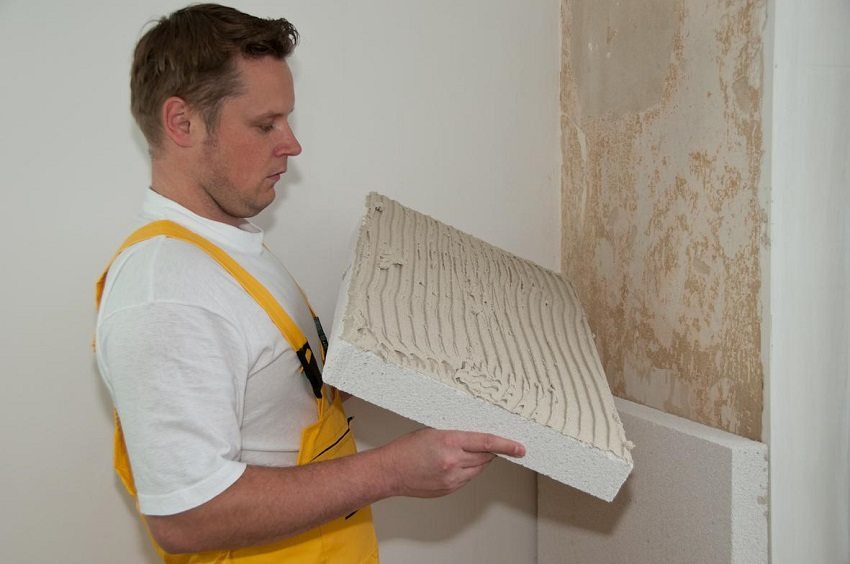
Extruded polystyrene foam, due to its heat resistance, reduces the heat loss to 90%
Useful advice!Use Epps for thermal insulation of the foundation of the house, as well as the cap and a basement.
Extruded polystyrene: insulation defects
In comparison with the foam deficiencies in Epps is much less, but they are available.
Disadvantages insulation Epps:
- Poor water vapor transmission rate - need to install a good ventilation system, as the walls of the room after warming virtually "breathe".
- Despite the fact that the flammability index decreased significantly, the market has a large number of products made in violation of manufacturing technology.
- Due to careless attitude of some manufacturers to comply with the requirements for the production process and raw materials issue with the release of toxic substances it is unclear. In choosing the material should be carefully study the information about the manufacturer and its products.
- Higher price in comparison with the foam.

Characteristics of extruded polystyrene foam
If you can not perform the facade insulation, Epps use as insulation material is much safer than in the case of the foam. The main thing with this - to establish high-quality and effective ventilation.
Penoplex - a type of Styrofoam
Penoplex issued as foamed polystyrene plates, manufactured using a special extrusion process. The material is obtained by forcing the plastic mass, which was warmed and foamed. Punching through the nozzle for forming, called nozzles.
Due to the interaction of high temperature and high pressure during solidification becomes penoplex finely porous. Its structure consists of small air cells 100-200 microns, isolated from each other.
Note!Due to the unusual structure of polystyrene foam provides excellent insulation qualities and high strength (especially before the mechanical impact factors).

Penoplex has low thermal conductivity, waterproof and resistant to fire
There are a number of substances that can damage penoplex or deprive him of useful properties. These substances include:
- diesel fuel;
- coloring formulations based on oil;
- petrol;
- enamel colorants;
- based solvents methyl acetate or ethyl acetate;
- acetone and formaldehyde;
- Other substances with the active.

Installation of each type of insulation is carried out in accordance with the requirements and standards opredelennyni
Forms of insulation for the walls inside based on cotton
Mineral wool is present commercially as plates with different levels of density, as well as roll goods. It is used for thermal insulation of wall surfaces, roof and attic floor. You can use the material for interior insulation of rooms.
Note! On mineral wool insulation for walls inside the house price depends on the density (as well as other kinds of thermal insulation materials). The higher the score, the higher the cost of products.
Advantages of mineral wool insulation:
- Low flammability index (when burning material is accompanied with a gradual decay damping without isolation of smoke and harmful substances);
- excellent air and vapor permeability;
- favorable thermal performance;
- resistance to insects and rodents;
- insulating properties.

Glass wool is used for thermal and sound insulation of floors, basements, facades, internal and external walls
Disadvantages of the material:
- vulnerability to moisture and high absorbency with loss of useful properties;
- installation work require special clothing, which complicates the process of installing insulation;
- acquisition costs of protective materials (waterproofing and vapor barrier);
- eventually the mineral wool shrinks.
On the market are two more varieties of insulation based on wool: glass wool material and ecowool.
Glass wool has substantially the same properties as the mineral wool insulation, but it is more elastic and resistant to vibration effects. Its main drawback - a dangerous impact on the human body, which complicates the process of installation mounting.
Ecowool contrary is considered one of the most environmentally friendly insulation, but the cost of this material relevant.

Ecowool not recommend use with insulation and basement slabs on basements where the humidity level consistently high
Features foil and liquid insulation for building walls
Insulation for thermal insulation of walls of the liquid is considered to be the thinnest. On the external characteristics he looks like an ordinary coloring formulation. The only thing that distinguishes it - a structure consisting of microscopic spheres of vacuum forming Insulating effect.
This kind of material appeared on the market relatively recently, but due to its high cost is not so popular among consumers as others. Types of heaters, which were considered earlier.
Note! According to information from the manufacturer zhidkokeramicheskogo 1mm interlayer insulating material has the same capabilities as the mineral wool, which layer thickness does not exceed 5 cm. This advantage is largely justifies the high cost of the material in comparison with others.

Foil is a multilayer insulation material, consisting of polyethylene closed-foam structures of varying thickness and aluminum foil
Often used insulation with foil to the walls inside the house in the country. Due to the reflective coating such material prevents heat out of the room. As a rule, the foil substrate manufacturers supplement or mineral foam products in plates and rolls.
Average prices for different types of insulating materials
A comparative table of the value of organic and inorganic reflective insulation:
| Material type | Name | Cost, rub. / M² |
| organic | wood-concrete thermopanel | 520 (2 pcs. = 1 m) |
| Penoizol (leaf) | 1200 (m³) | |
| MEP steak Standard | 173-1713 | |
| Polyurethane foam | 400-850 | |
| Ecowool | 1700-5000 (m³) | |
| Penoplex (Comfort) | 1197-1447 | |
| reflective | Armofol (Extra) | 70-165 |
| Porileks (IPP) | 650-1450 | |
| Ekofol (one-way) | 1440-1656 | |
| penofol 2000 | 51-355 | |
| inorganic | Mineral wool | 310-820 |
| fiberglass | 400-1350 | |
| AkTerm (zhidkokeramicheskaya insulation) | 3200-7200 (10-20 l) | |
| stone wool | 335-1320 (m³) | |
| Liquid rubber | 750-850 |
Foil insulation, wall insulation materials are a reflection type. They are called reflex, because they slow the movement of heat fluxes, namely infra-red radiation.
By reflex materials include aluminum and polished, which happens to be single and double layer. To improve the effect of the metallized layer is complemented by a foamed polyethylene. These materials include: Porileks, Ekofol, Penofol, Armofol.
To make the right choice insulation is good enough to study the advantages and disadvantages of each of the materials and, comparing them with your budget possibilities, as well as operating conditions of the room, you will be able to select suitable products.
